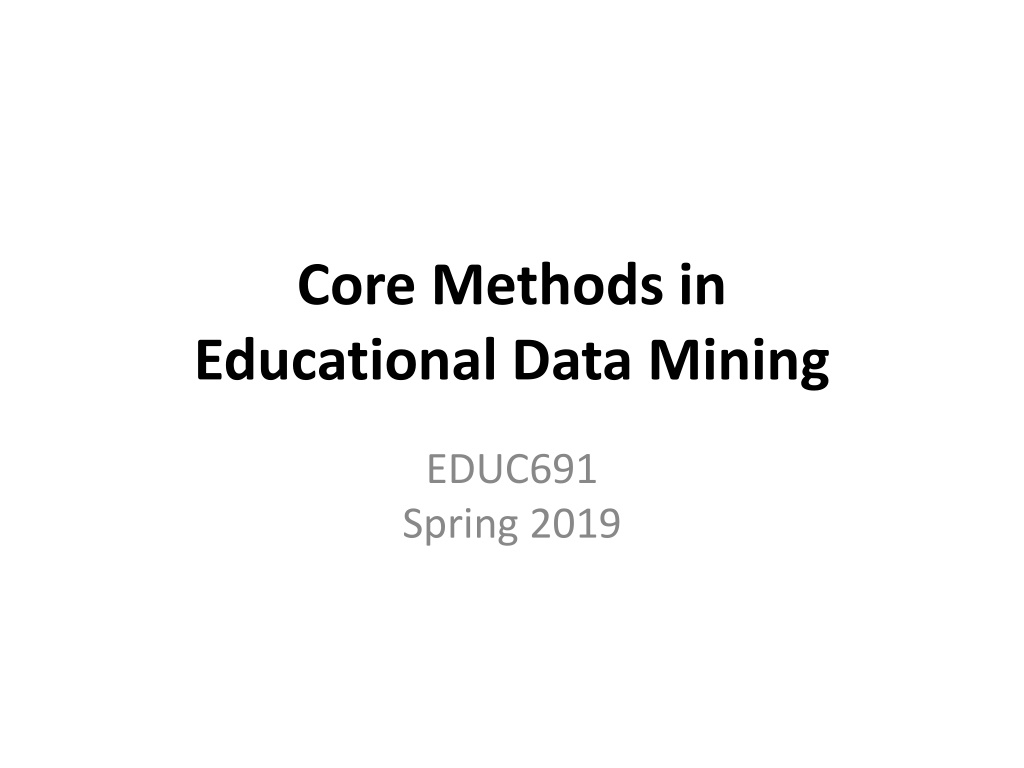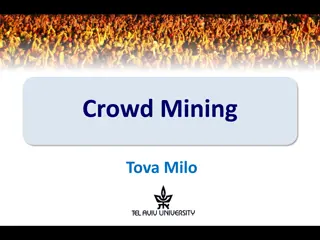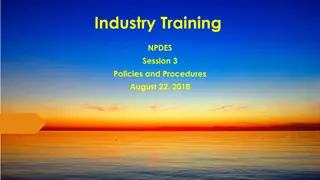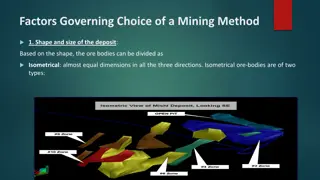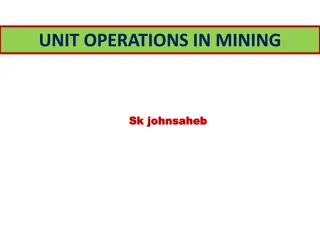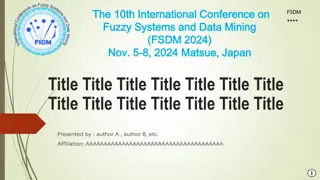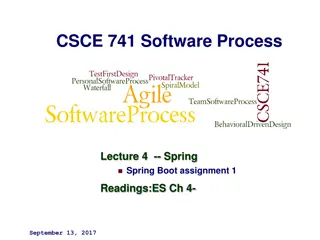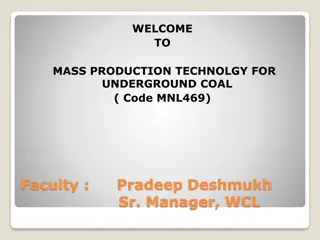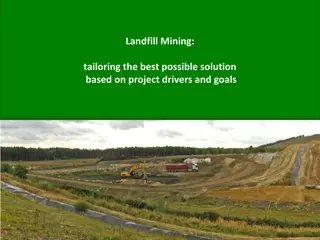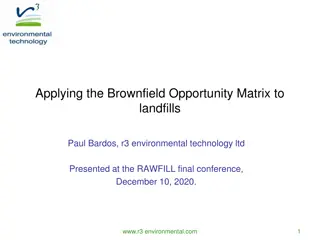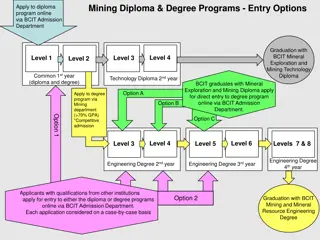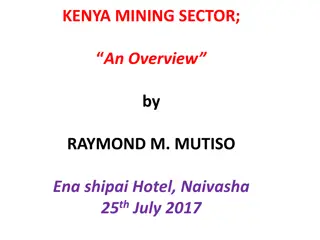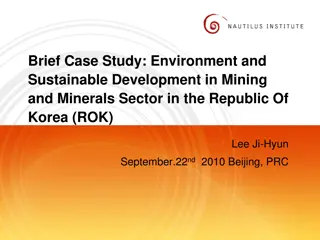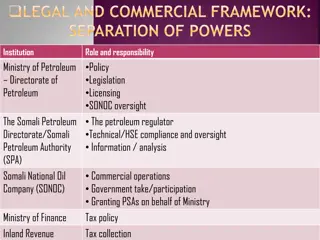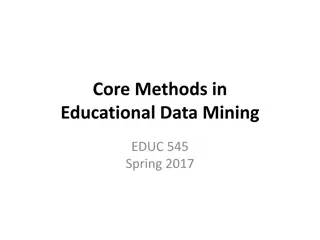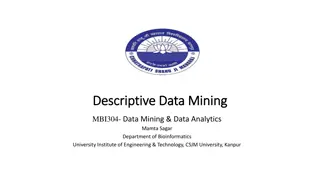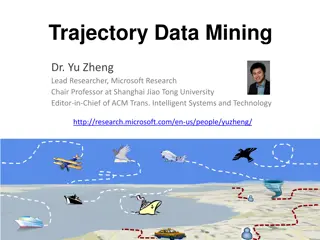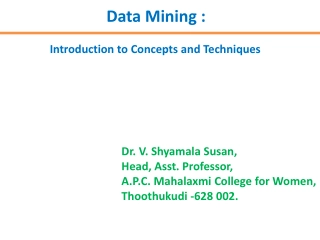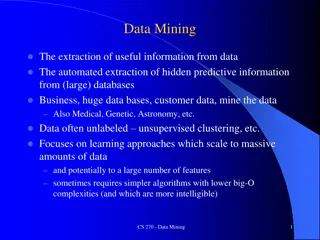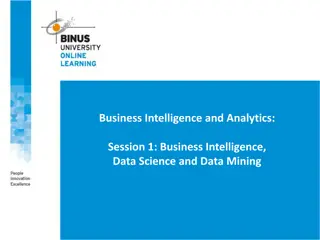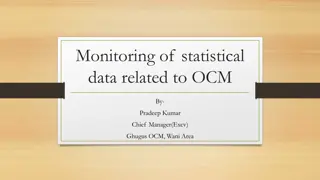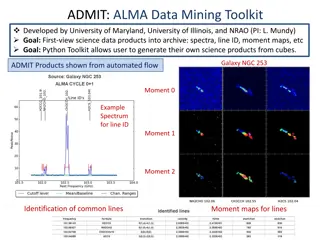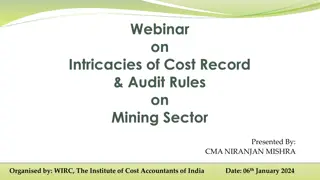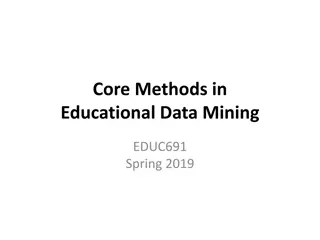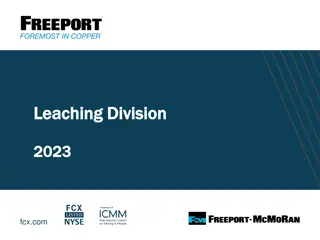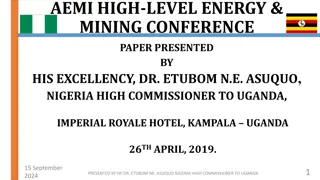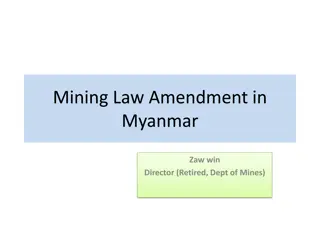Exploring Core Methods in Educational Data Mining - EDU691 Spring 2019
Delve into the world of educational data mining with Core Methods in Educational Data Mining course content from Spring 2019. From basic homework assignments to analyzing the impacts of variables on decision tree algorithms, discover the challenges and differences between Python and RapidMiner tools. Explore the nuances of overfitting, variable selection, model applicability, and the effects of cross-validation in data analysis.
Download Presentation

Please find below an Image/Link to download the presentation.
The content on the website is provided AS IS for your information and personal use only. It may not be sold, licensed, or shared on other websites without obtaining consent from the author. Download presentation by click this link. If you encounter any issues during the download, it is possible that the publisher has removed the file from their server.
E N D
Presentation Transcript
Core Methods in Educational Data Mining EDUC691 Spring 2019
The Homework Let s go over basic homework 1
The Homework Let s go over basic homework 1 Who did the assignment in Python? Who did the assignment in RapidMiner?
RapidMiner folks How well did you succeed in making the tool work? What were some of the biggest challenges?
Python folks How well did you succeed in making the tool work? What were some of the biggest challenges?
Did it make a difference? When you ran Decision Tree/W-J48 with an without student as a variable in the data set? What was the difference?
Did it make a difference? When you ran Decision Tree/W-J48 with an without student as a variable in the data set? What was the difference? Why might RapidMiner and Python produce different results for this?
Removing student from the model How did you remove student from the model? There were multiple ways to accomplish this
How would you know If you were over-fitting to student? Or any variable, for that matter?
What are some variables That could cause your model not to apply to new data sets you might be interested in? Student is one example what else?
Did it make a difference? What happens when you turn on cross- validation?
How are you liking RapidMiner and Python?
Other RapidMiner or Python questions?
Note Python and RapidMiner have a different set of algorithms available Python s set tends to be more recent But it s not totally clear they are *better* We ll come back to this when we discuss Hand
What is the difference between a classifier and a regressor?
What are some things you might use a classifier for, in education? Bonus points for examples other than those in the BDE videos
Any questions about any classification algorithms?
Do folks feel like they understood logistic regression? Any questions?
Logistic Regression m = 0.5A - B + C A B C M P(M) 0 0 0
Logistic Regression m = 0.5A - B + C A B C M P(M) 0 0 1
Logistic Regression m = 0.5A - B + C A B C M P(M) 0 1 1
Logistic Regression m = 0.5A - B + C A B C M P(M) 4 1 1
Logistic Regression m = 0.5A - B + C A B C M P(M) 100 -100 100
Why would someone Use a decision tree rather than, say, logistic regression?
Has anyone Used any classification algorithms outside the set discussed/recommended in the videos? Say more?
Other questions, comments, concerns about lectures?
Did anyone read Hand article? Thoughts?
What is Hands main thesis? Who thinks it makes sense? Who thinks he s probably wrong?
What is Hands main thesis? Who thinks it makes sense? Who thinks he s probably wrong? Please present arguments in favor of each perspective
If he is wrong Why do simple algorithms work well for many problems?
If he is right Why have some algorithms like recurrent neural networks become so popular?
If he is right Why have some algorithms like recurrent neural networks become so popular? Note that many of the key successes have been in very large scale data sets like voice recognition
One of Hands key arguments Data points trained on are not usually drawn from the same distribution As the data points where the classifier will be applied
One of Hands key arguments Data points trained on are not usually drawn from the same distribution As the data points where the classifier will be applied Is this a plausible argument for educational data mining?
One of Hands key arguments Data points trained on are not usually drawn from the same distribution As the data points where the classifier will be applied Is this a plausible argument for large-scale voice recognition technology?
Another of Hands key arguments Data points trained on are often treated as certainly true and objective But they are often arbitrary and uncertain
Another of Hands key arguments Data points trained on are often treated as certainly true and objective But they are often arbitrary and uncertain Is this a plausible argument for educational data mining?
Another of Hands key arguments Data points trained on are often treated as certainly true and objective But they are often arbitrary and uncertain Is this a plausible argument for large-scale speech recognition?
Note Hand refers to these issues as over-fitting But they are a specific type of over-fitting that is relevant to some problems and not to others And is different than the common idea that over-fitting comes from limited data
Another of Hands key arguments Researchers and practitioners usually do best when working with an algorithm they know very well And therefore more recent algorithms win competitions Because those are the algorithms the researcher knows best and wants to prove are better
Momentary digression Who here is familiar with data competitions like the KDD Cup, Kaggle competitions, and ASSISTments Longitudinal Challenge?
Some counter-evidence to Hand Recent algorithms win a lot of data mining competitions these days (where lots of people are trying their best)
Some counter-evidence to Hand Recent algorithms win a lot of data mining competitions these days (where lots of people are trying their best) Those of you who like Hand, how would you respond to this?
Some counter-evidence to Hand One possible rejoinder: These are usually well- defined problems where the training set and eventual test set resemble each other a lot
Should you Pick one algorithm that seems really appropriate? Run every algorithm that will actually run for your data? Something in between?
My typical lab practice Pick a small number of algorithms that Have worked on past similar problems Fit different kinds of patterns from each other
Is it really the algorithm? Or is it the data you put into it? We ll come back to this in the Feature Engineering lecture in a month
